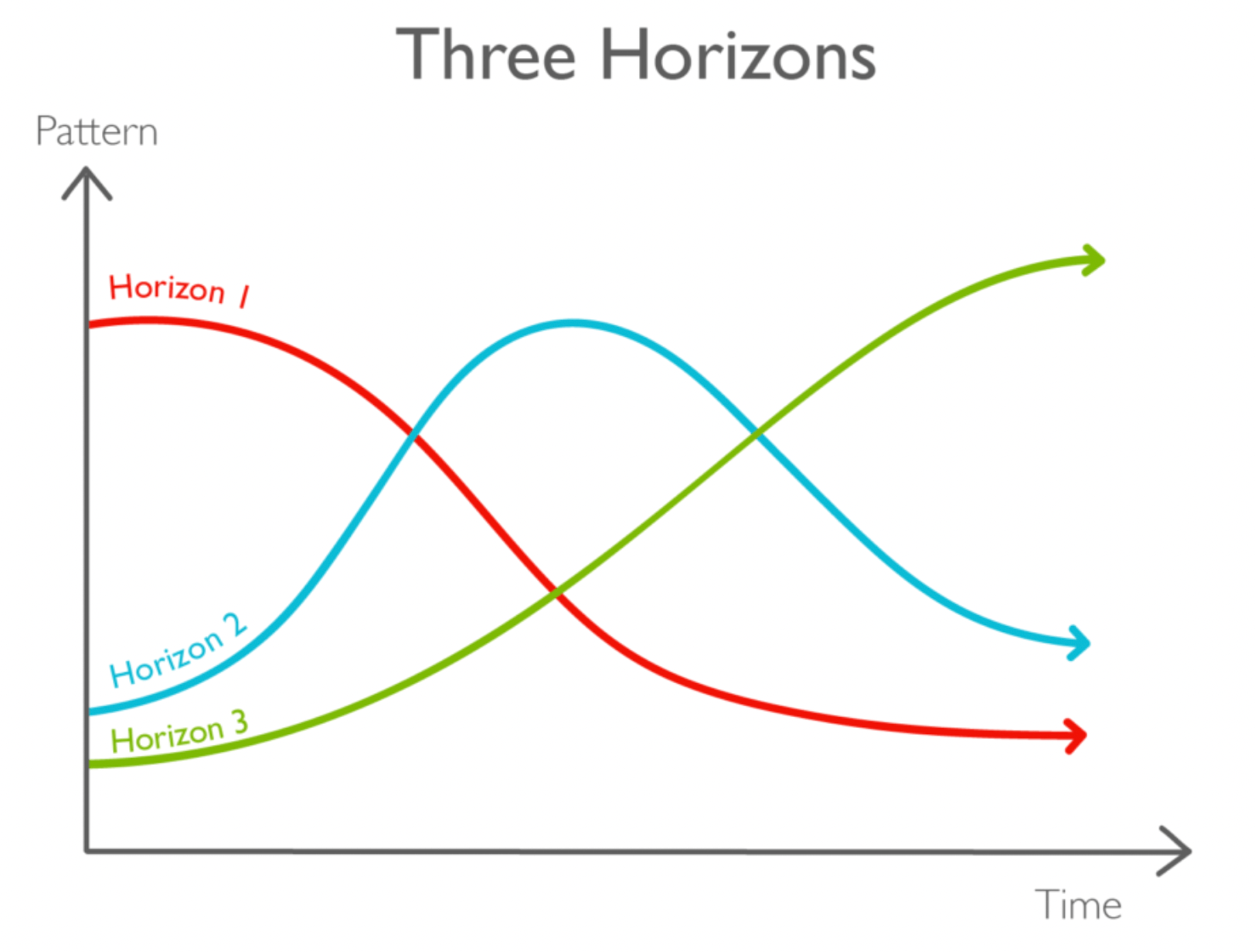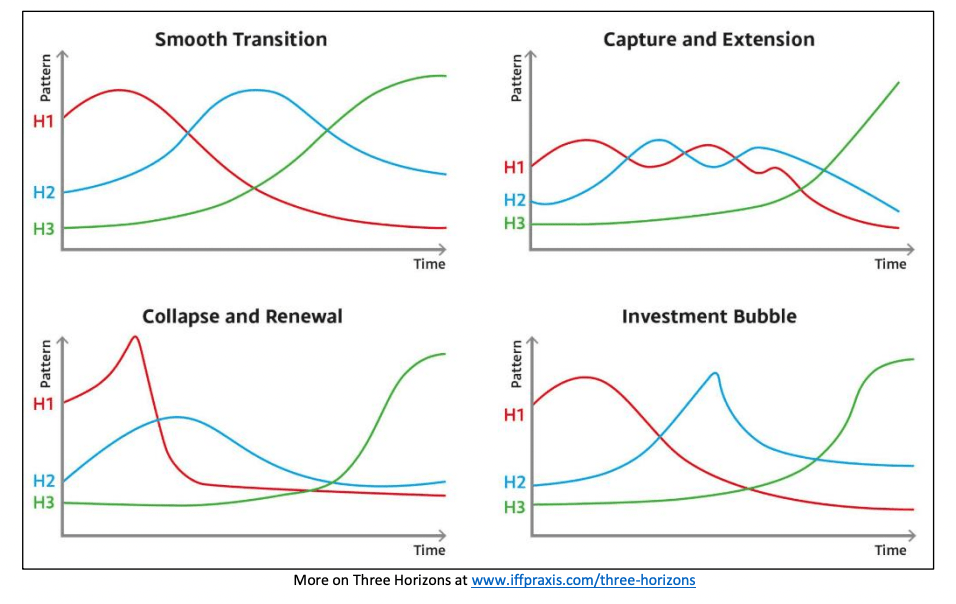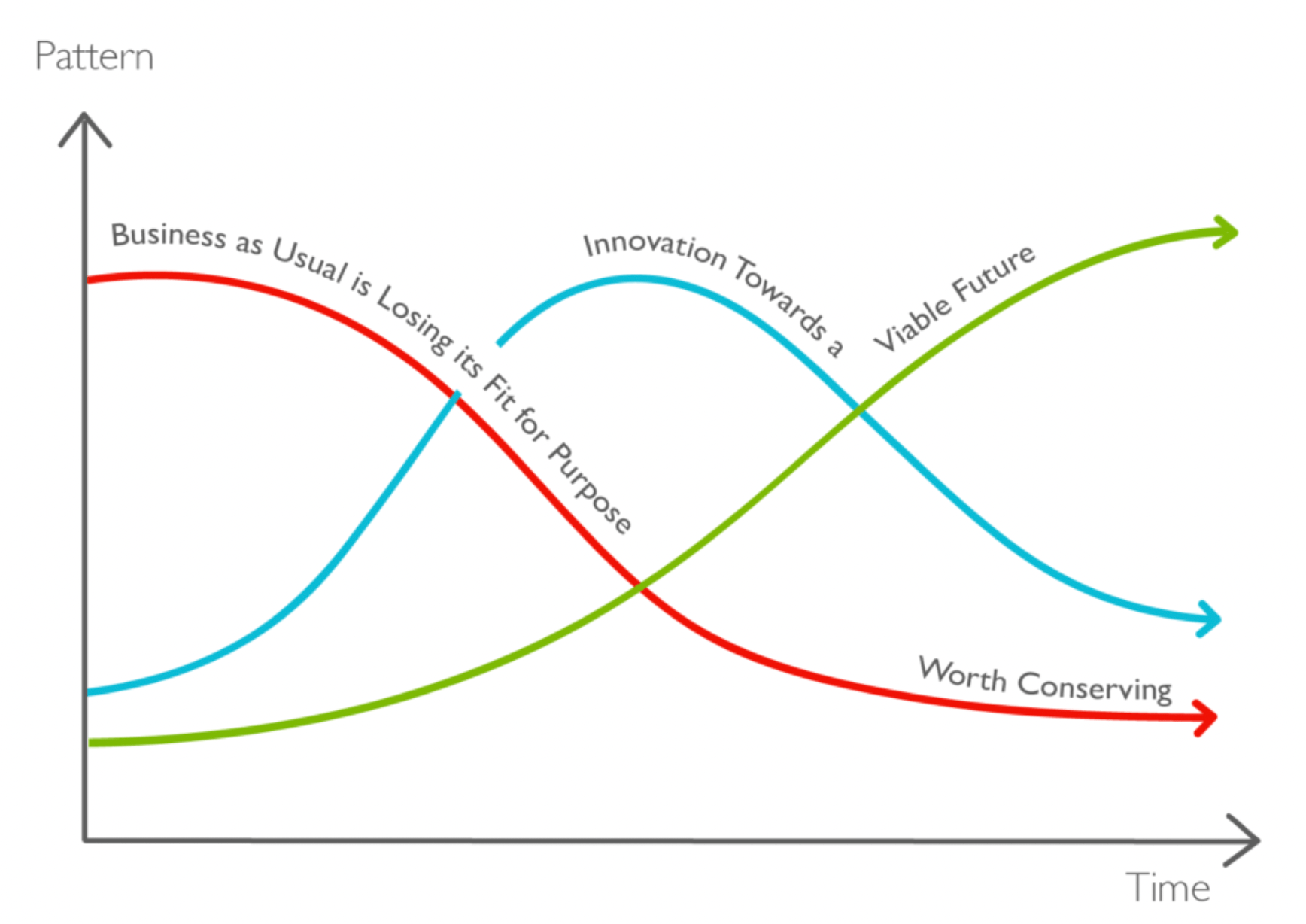Thinking In Three Horizons
It’s hard to talk about what you’re going to do in the future, especially if you don’t have a shared language or sense of time.
Entrepreneurs and CEOs love to talk about growth and innovation goals, but it can be hard to see how these fit into our day-to-day activities.
One of the most helpful tools for thinking about growth is the Three Horizons diagram by McKinsey, made famous in the book The Alchemy of Growth.
It describes three different “horizons” or timeframes that flow together, but each horizons represents a different type of growth.
That nudges us to draw out our plans for improving today’s business, to dream up a big vision for the long term, and then start designing new business units that can bridge the present and the future.
Here are the three horizons:
Horizon 1 (H1) – 6 months to 3 years
Horizon 2 (H2) – 2-5 years
Horizon 3 (H3) – 5-12 years
McKinsey draw them out like this, as three stages that build on each other:
Alchemy Of Growth, Baghai et al
That model is appealing for large corporations, whose plan is to go from strength to strength.
An alternative version was drawn by Bill Sharpe, that better represents the reality of the social entrepreneur:
Bill Sharpe + H3Uni.org
In this version, we see that the current systems and businesses in H1 have a limited lifespan, and are ideally going to be replaced by an emerging set of systems in H3, bridged by a temporary H2.
Both versions of the diagram are helpful, and the latter has several variations:
Bill Sharpe + H3Uni.org
Crucially, there is no fixed path or template that will apply to all situations.
Your job is to model the most likely set of horizons for your work.
This is a tool for thinking about growth, not a set of rules or limitations.
It’s job is to help you see how the pieces of the future fit together, and understand how the seeds you plant today might grow into something remarkable down the track.
A good example of this was Elon Musk’s vision for electric cars.
His long term goal was to make electric vehicles affordable and desirable, two thing that were greatly limited by the technology at the time, particularly because the distance you could drive was so limited
The interim goal in H2 was the “Gigafactory” – a battery production plant designed to massively increase performance and drive down costs.
The battery factory might not be the big vision, but it enabled Tesla to outpace their competitors with a big technological advantage.
Irrespective on your current views on Musk, this H2 thinking was clever.
The benefit of this whole process comes from “digging your well before you’re thirsty” – to do the groundwork in designing future systems before you depend on them for your survival.
Easier said than done.
Let’s look at what each horizon specifically refers to:
H1: Growth in the “business as usual”
This refers to improvements in the things you’re already good at.
e.g. new products, improved pricing, new campaigns, better systems and processes, a new hire, or maybe a second location.
This is also a good time to look at why this work might be strained, threatened or becoming obsolete.
You might be running your business in a way that can’t last for long, that isn’t sustainable, or won’t be relevant in the near future.
Change might not be a bad thing?
H2: New and emerging models
In this horizon, you get to use your strengths in a new way, perhaps by entering a new market or by designing a new menu.
This might be considered disruptive, and unpopular with your competitors.
It’s a good time to look at where these new changes are already working elsewhere, to see what you can learn from your peers and predecessors.
H3: Transformative growth with a long lead time
In this horizon, you’re likely to be doing things you might not be good at today, or working in a field that barely exists.
This is your chance to describe and design the sort of work you want to be doing, even if it’s not what the market is asking for today.
It’s a good time to describe your vision for the future, even if that future is several iterations away.
Good Prompts For H2 and H3
You’ll likely have a list of growth options for H1, but H2 and H3 are often murkier.
Here are three prompts for thinking about the future:
“What would a startup do?”
Large or established businesses feel an obligation to keep all of their current work going as they plan their futures.
A startup, on the other hand, would not be burdened by any of those expectations and complexities, they’d likely skip straight to the future models with 100% of their effort.
What traditions or industry practices would a new business ignore?
Where would they spend their time?
Where would they be weaker because of their lack of resources?
Where would they be faster because of their lack of baggage?
“You can’t fatten the pig on market day”
Some things in life can’t be rushed, they need time to develop.
If you want a better result, you might need to have put in a consistent effort, even small efforts, in advance.
This is similar to the proverb “nine women can’t make a baby in one month”; more people or more money can’t speed up every process, particularly where trust, reputations or technology are involved.
What benefits from compound interest?
What needs to happen gradually in order to produce great results in a few years?
What assets need to be built?
What relationships need to be developed?
“What would our competitors hate for us to do?”
A great question for finding the most valuable path – what would you not want to see your rivals doing, or what would they hate to see you doing?
It’s a great test because your jealousy/concern highlights that you know a certain route will lead somewhere great.
If your rivals would be happy to see you focus somewhere, is that a sign that it’s a distraction or a dead end?
Bill Sharpe + H3Uni.org
Filling In The Three Horizons
There are no strict rules, but generally speaking the best place to map first is H1.
This lets us get a lot of the obvious or immediate growth projects our of our heads and up on the board.
These are the incremental changes or well-defined growth initiatives, some of which you’ve probably been discussing in recent weeks.
Because we’re looking at a 6 month to 3 year timeframe, these are bigger than “let’s fix up our website” or “we need to schedule that meeting”, we want a higher level of strategic thinking.
We also want to discuss whether or not we see this current system “eroding” or having an expiration date.
What might not have long left?
Some good questions for H1 include:
· What are our signature strengths?
· Am I looking for what’s broken or what’s working?
· Can we increase our market share?
· Could we raise prices?
· How might we cut our costs?
· How might we increase customer consumption?
· Could we rebuild our menu?
· How might we triple our online traffic?
· Could we attract more revenue by moving our paywall?
The next horizon to map, counterintuitively, might be H3.
This is where we get to describe the big picture and the distant future, one that is better than the realities of H1.
These are sentences that start with “we believe in a world where…”.
These do not have to be realistic today, but they should be comprehendible to the people in the room.
It might be several different versions of the future – we are working from trends, patterns, signals and intuition, so don’t expect immediate alignment on a single picture.
Some good questions for H3 include:
· What is our “Cathedral”, a multi-generational project we may never see completed?
· Do we actually need 10 years? Can we skip to the exciting part? Or is the industry not ready?
· What assets can we start building today that are going to be valuable in 10 years time?
· Who would be the ultimate predator business? How might we become that predator?
· Are we thinking too small?
· Am I dragging outdated assumptions and biases into this future venture?
Lastly, we get to map H2 – the bridge between the present and the ideal future.
H2 initiatives can come from stretching out the things you’re already good at in H1, or by reverse engineering the systems you want to see in H3.
e.g. Netflix saw an H3 where streaming movies was accessible in all households, but needed to build their DVDs-in-the-post business in H2 while technology caught up.
Some good questions for H2 include:
· What can we do now that will make everything else easier?
· What would we love to have on our menu? What would be the perfect cross-sell for our customers?
· What are our customers asking us to build? Can we start a different business that we can push downhill?
· Are we courageous enough to abandon the past?
· Can we foster relationships today that might become valuable in 18 months time?
· What if we began selling to a different type of customer?
· Could we design a higher value product or service?
· How might we money while we sleep?
· How can we reduce key person risk?
The 70/20/10 Rule
The most common advice for allocating your energy for these initiatives is a 70/20/10 split.
This gives you 70% of your time and attention for the H1 projects that ensure your survival, there’s not much point in having big plans if the entire company has long since collapsed.
20% of your time goes towards designing and building the next wave of projects and business units, which can both complement and replace your current work, even if only for a season.
10% of your time goes towards the more distant future, to conversations, partnership and strategizing about what you’ll need to create and to start planting the seeds that may eventually become what sustain you in the future.
This is a guide, but it’s helpful to explicitly talk to your team about where they have permission to dream, scheme and develop, versus when they will need to keep the current business running smoothly.
Trade-Offs And Your Margin Mix
You’ll constantly be making trade-off decisions, particularly around where you spend your time, attention and money.
The Three Horizons are helpful for thinking about your Margin Mix; your combination of Cash Cows, Small Margins and Loss Leaders.
Each of these three can be great for your business, but in the right proportion.
For example, you might choose to retain your Cash Cows in H1 in order to subsidise your Loss Leader work in developing H3.
Alternatively, you might do Loss Leader and Small Margin work in H2 in order to have an advantage in creating Cash Cows in H3.
Again, there are no strict rules here, the benefit is in the shared language and understanding of timeframes.
Try mapping out your Three Horizons with your team.
The first drafts will be ugly, but they’ll get you talking about what you want to defend, what you dream of creating, and how you might get there in the next few years.







